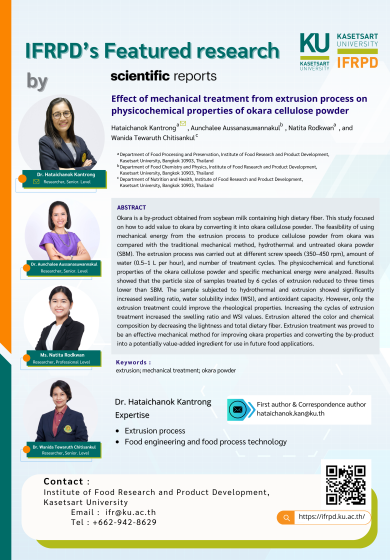| ผลงานวิจัย | ดร.หทัยชนก กันตรง และคณะ |
| Keywords | extrusion; mechanical treatment; okara powder |
| Telephone | 0 2942 8629 (1612) |
| hataichanok.kan@ku.th | |
| URL | https://doi.org/10.1038/s41598-024-73819-5 |

Effect of mechanical treatment from extrusion process on physicochemical properties of okara cellulose powder

| ผลงานวิจัย | ดร.หทัยชนก กันตรง และคณะ |
| Keywords | extrusion; mechanical treatment; okara powder |
| Telephone | 0 2942 8629 (1612) |
| hataichanok.kan@ku.th | |
| URL | https://doi.org/10.1038/s41598-024-73819-5 |
จุดเด่นผลงาน
บทสรุป : งานวิจัยนี้มุ่งเน้นศึกษาความเป็นไปได้ในการใช้พลังงานกลจากกระบวนการเอกซ์ทรูชันในการผลิตผงกากถั่วเหลืองซึ่งเป็นผลพลอยได้จากการผลิตน้ำเต้าหู้ ไม่เพียงแต่เป็นการเพิ่มมูลค่าให้กับกากถั่วเหลืองแต่ยังเป็นแนวทางในการผลิตเซลลูโลสในระดับอุตสาหกรรม เนื่องจากกระบวนการเอกซ์ทรูชันเป็นกระบวนการที่มีต้นทุนในการผลิตต่ำ มีกำลังการผลิตสูง ลดการใช้สารเคมีในกระบวนการ และเป็นมิตรต่อสิ่งแวดล้อม จากนั้นได้มีการศึกษาคุณสมบัติเชิงเคมีฟิสิกส์และคุณสมบัติเชิงหน้าที่ของผงกากถั่วเหลืองที่ได้และผลการศึกษาพบว่า กระบวนการเอกซ์ทรูชันสามารถลดขนาดอนุภาคได้ดี อีกทั้งยังช่วยปรับปรุงคุณสมบัติทางเคมีฟิสิกส์ต่าง ๆ และคุณสมบัติเชิงสุขภาพได้อีกด้วย
Abstract : Okara is a by-product obtained from soybean milk containing high dietary fiber. This study focused on how to add value to okara by converting it into okara cellulose powder. The feasibility of using mechanical energy from the extrusion process to produce cellulose powder from okara was compared with the traditional mechanical method, hydrothermal and untreated okara powder (SBM). The extrusion process was carried out at different screw speeds (350–450 rpm), amount of water (0.5–1 L per hour), and number of treatment cycles. The physicochemical and functional properties of the okara cellulose powder and specific mechanical energy were analyzed. Results showed that the particle size of samples treated by 6 cycles of extrusion reduced to three times lower than SBM. The sample subjected to hydrothermal and extrusion showed significantly increased swelling ratio, water solubility index (WSI), and antioxidant capacity. However, only the extrusion treatment could improve the rheological properties. Increasing the cycles of extrusion treatment increased the swelling ratio and WSI values. Extrusion altered the color and chemical composition by decreasing the lightness and total dietary fiber. Extrusion treatment was proved to be an effective mechanical method for improving okara properties and converting the by-product into a potentially value-added ingredient for use in future food applications.
Scientific Reports 14, Article number: 22193 (2024)